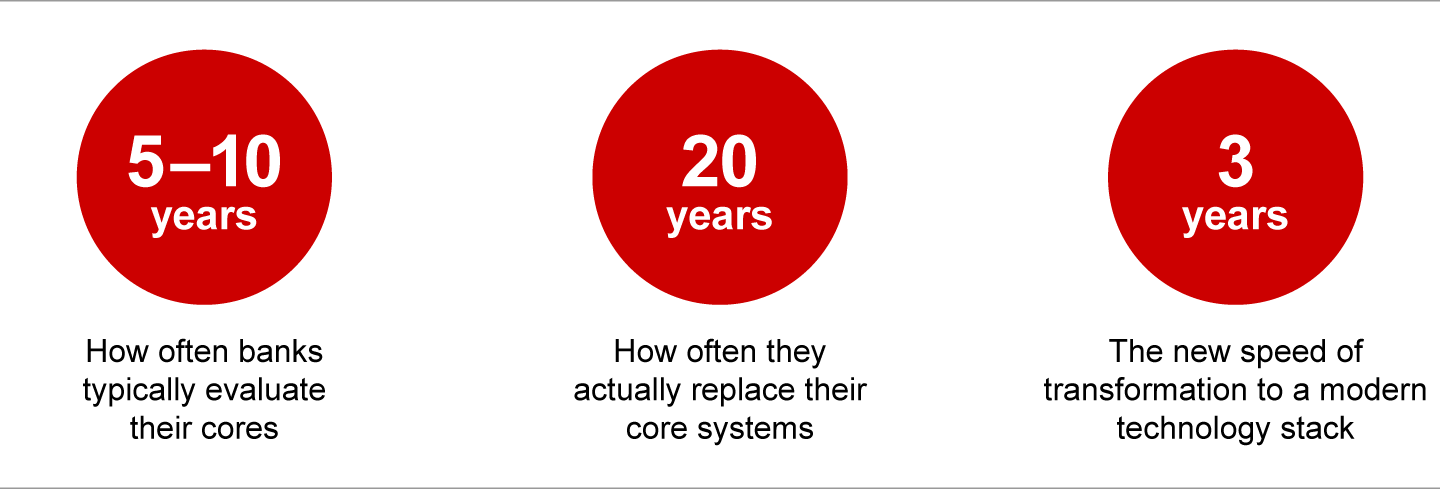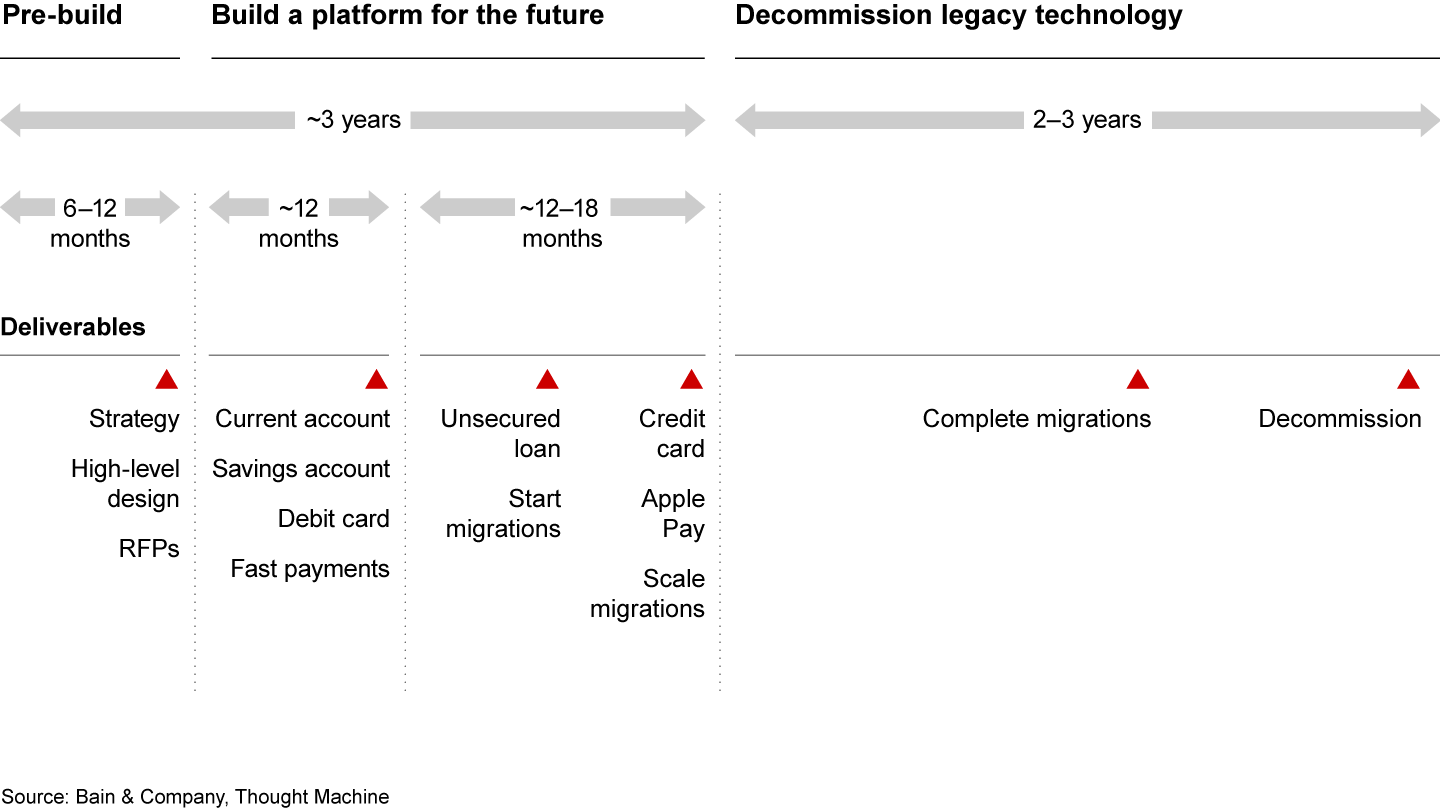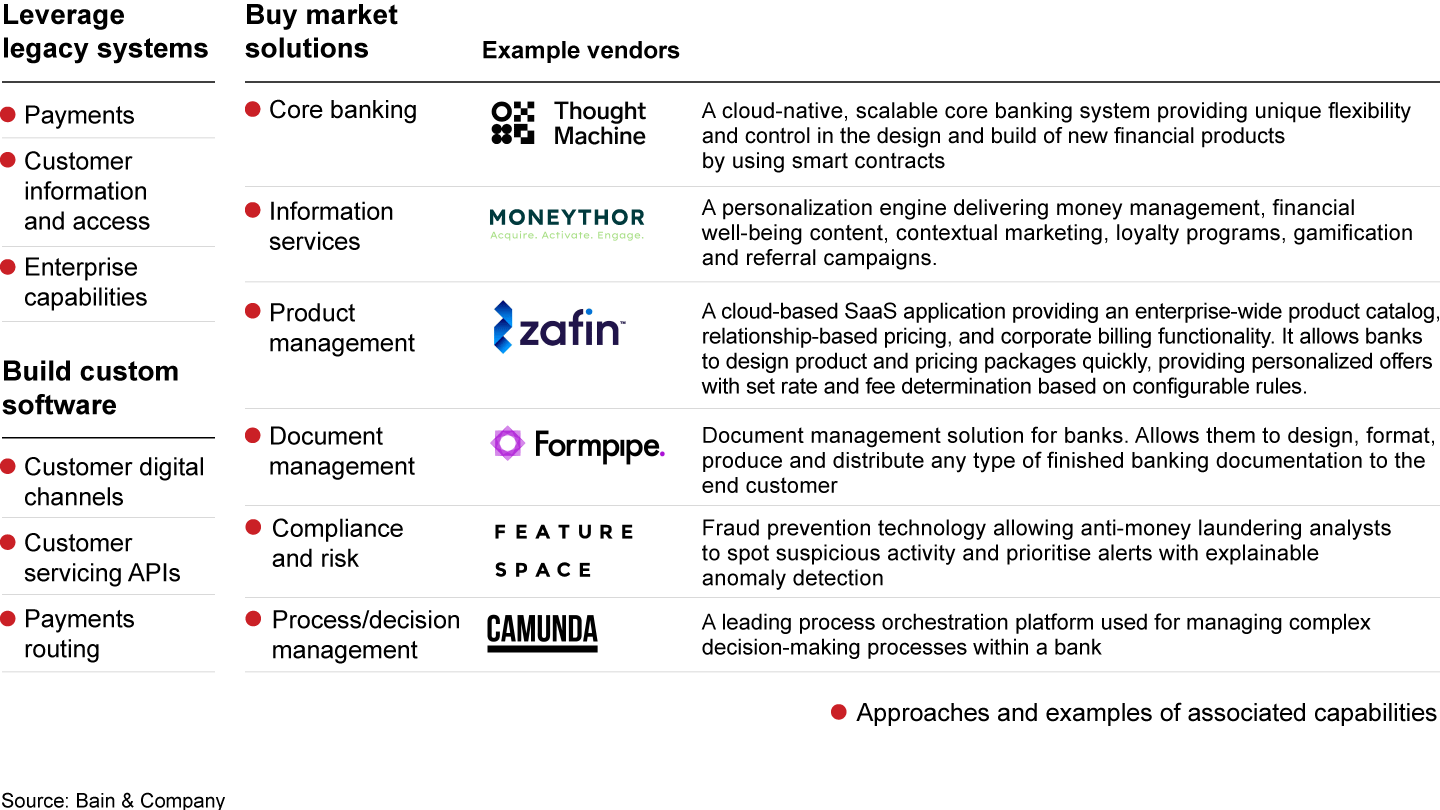Article

Today’s banking customers expect better service and faster innovation. While fintech banks have the technology to rapidly deploy new products and experiences, incumbents are held back by convoluted and costly core systems that are unsuited to modernization.
To thrive in the long run, banks need flexible and scalable platforms. But replacing core technology is a challenge that can cost hundreds of millions of dollars, strain operating models, and introduce risk. As a result, banks often postpone these transformations; the average tenure for core banking systems is around 20 years (see Figure 1).

A number of leading banks are taking a faster, phased approach to implementing future-ready architectures, one that mitigates risk and provides a superior customer experience. Rather than rebuild an entire legacy tech stack, banks build a modern platform in phases, for example by using Vault Core, Thought Machine’s powerful, cloud-native core banking platform.
This approach enables the creation of a new bank—either as a separate brand or as a digitally focused sub-brand—with an entirely new stack. Banks can quickly attract and serve new customers, providing them more choice and flexibility, while simultaneously supporting a large-scale migration as a second stage.
Quick results without make-or-break risks
We begin by working closely with banks to create a blueprint for the target architecture. We first identify the products, capabilities, and accounts that can move to a new tech stack, then help the bank migrate the portion of its customer base that has simple and homogenous needs. This new bank, running on a new stack, can begin operating while maintaining a loose coupling to existing parts of the legacy stack.
Launching this new bank allows the established bank to quickly offer the experiences and products modern customers expect. At the same time, the foundations are in place to reduce legacy costs thanks to the leaner, automated processes being put in place. A test-and-learn approach allows the bank to adjust its technology and operating models.
With these efficiencies in place, we help the established bank migrate more complex capabilities, products, and accounts. Through careful integration and phased migration, the organization can make course corrections as it progresses toward a full-scale transformation and complete customer migration. In time, the established bank can decommission its old platform without the make-or-break risk of a big-bang migration.
This modernization program comprises three stages: strategy, build, and decommissioning (see Figure 2). Of note, Bain has helped fintechs launch products on a modern core after just 12 months—significantly faster than the average 4.7 years to implement a new core banking system and launch products using a traditional approach.

Although this staged approach may require several years to reach completion, banks can achieve meaningful results quickly.
Early proof of significant results
A leading European bank is pursuing this strategy, and its results have been impressive. The bank recently launched a new core banking platform that can scale as it adds functionality and complexity. Key statistics include:
- Investment declared: €650 million from 2022–2025, of which €280 million was invested from 2022 to 2023 (includes the entire new bank setup, not just the core)
- Timing: 12 months to build, launched to employees in March 2023 and to customers in June 2023
- Target customers: Up to one-third of the bank’s customers (with the initial batch migrated in October 2023)
- Business ambition: The new digital bank expects to have a cost-to-income ratio (CIR) of less than 30% by the end of 2025; reaching this target will create €800 million in run-rate savings for the parent company by 2027.

What Makes Digital Attacker Banks So Efficient?
Digital-only banks have gained ground with consumers, and have lower operating costs than incumbent banks. Here’s why.
Other banks pursuing a similar approach include Standard Chartered, SEB, and Al Rajhi Bank Malaysia. Each is using Thought Machine’s Vault Core to modernize in timeframes unthinkable a decade ago, launching digital banks in less than two years (from conception to available products).
- Mox Bank: Standard Chartered’s digital greenfield offering in Hong Kong, Mox went from licensing to market deployment in just 18 months.
- SEB: Launched SEB Embedded, enabling businesses to offer financial services under their own brands, without a banking license.
- Rize: Al Rajhi Bank Malaysia launched Rize in 2023, offering a range of sophisticated, Shariah-compliant financial products to retail and SME customers.
A crucial partner for a complex journey
The key to this approach is achieving the optimal balance between building a sufficiently independent new stack—unconstrained by monolithic legacy limitations—and leveraging newly modernized capabilities that facilitate customer migration.
While banks can leverage their legacy stack for some functions (including payments and enterprise tech) many others can be addressed with new, best-in-class solutions that offer pre-built integration to the new core (see Figure 3). In some cases (such as consumer digital channels) capabilities that are critical for differentiation will require custom-built solutions.

It’s important to note that the choice between legacy, new-buy, and new-build components will make or break the customer experience (and project costs) during migration. Banks must ensure correct routing between postings for accounts on old and new cores, and workable solutions for validation, clearing, and settlements. The wrong choices can lead to rework or more disruption to the customer experience (e.g., changes in account numbers and sort codes).
How to stay on track
While there is value in creating a flexible new bank, the dual-run costs incurred as customers exist on both platforms can be substantial, not to mention the added risks of operating two platforms. Five simple safeguards can help established banks minimize the cost and risk of transformation:
- Make upfront and continuous business simplification a CEO priority
- Provide clarity on the target and interim architectures, driven by in-depth analysis of each capability
- Address customer migration from the start, with trade-offs aligned with the business
- Create an ambitious delivery roadmap, supported by substantial investment in the right talent
- Maintain commitment and organization-wide focus from launch to completion
With these safeguards in place, the phased approach serves as a winning formula for incumbent banks aiming to modernize and gain a competitive edge against traditional competitors. This is especially crucial as competitors actively pursue innovation, with digital challengers setting the pace. The biggest payoff comes, however, once a bank completely migrates clients to the new platform and can decommission its legacy systems.

About Thought Machine
Thought Machine has developed the foundations of modern banking with its cloud-native core banking and payments technology. Its cloud-native core banking platform, Vault Core, is trusted by leading banks and financial institutions worldwide. For more information, visit thoughtmachine.net


